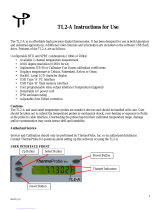
UM10310 All information provided in this document is subject to legal disclaimers. © NXP B.V. 2010. All rights reserved.
User manual Rev. 2 — 1 November 2010 5 of 139
NXP Semiconductors
UM10310
P89LPC9321 User manual
1.2 Pin description
Table 1. Pin description
Symbol Pin Type Description
P0.0 to P0.7 I/O Port 0: Port 0 is an 8-bit I/O port with a user-configurable output type. During reset
Port 0 latches are configured in the input only mode with the internal pull-up
disabled. The operation of Port 0 pins as inputs and outputs depends upon the
port configuration selected. Each port pin is configured independently. Refer to
Section 4.1 “
Port configurations” for details.
The Keypad Interrupt feature operates with Port 0 pins.
All pins have Schmitt triggered inputs.
Port 0 also provides various special functions as described below:
P0.0/CMP2/ KBI0 3 I/O P0.0 — Port 0 bit 0.
O CMP2 — Comparator 2 output.
I KBI0 — Keyboard input 0.
P0.1/CIN2B/
KBI1
26 I/O P0.1 — Port 0 bit 1.
I CIN2B — Comparator 2 positive input B.
I KBI1 — Keyboard input 1.
P0.2/CIN2A/
KBI2
25 I/O P0.2 — Port 0 bit 2.
I CIN2A — Comparator 2 positive input A.
I KBI2 — Keyboard input 2.
P0.3/CIN1B/
KBI3
24 I/O P0.3 — Port 0 bit 3. High current source.
I CIN1B — Comparator 1 positive input B.
I KBI3 — Keyboard input 3.
P0.4/CIN1A/
KBI4
23 I/O P0.4 — Port 0 bit 4. High current source.
I CIN1A — Comparator 1 positive input A.
I KBI4 — Keyboard input 4.
I AD13 — ADC1 channel 3 analog input.
P0.5/CMPREF/
KBI5
22 I/O P0.5 — Port 0 bit 5. High current source.
I CMPREF — Comparator reference (negative) input.
I KBI5 — Keyboard input 5.
P0.6/CMP1/ KBI6 20 I/O P0.6 — Port 0 bit 6. High current source.
O CMP1 — Comparator 1 output.
I KBI6 — Keyboard input 6.
P0.7/T1/KBI7 19 I/O P0.7 — Port 0 bit 7. High current source.
I/O T1 — Timer/counter 1 external count input or overflow output.
I KBI7 — Keyboard input 7.
P1.0 to P1.7 I/O, I
[1]
Port 1: Port 1 is an 8-bit I/O port with a user-configurable output type, except for
three pins as noted below. During reset Port 1 latches are configured in the input
only mode with the internal pull-up disabled. The operation of the configurable
Port 1 pins as inputs and outputs depends upon the port configuration selected.
Each of the configurable port pins are programmed independently. Refer to
Section 4.1 “
Port configurations” for details. P1.2 to P1.3 are open drain when
used as outputs. P1.5 is input only.
All pins have Schmitt triggered inputs.
Port 1 also provides various special functions as described below:




















